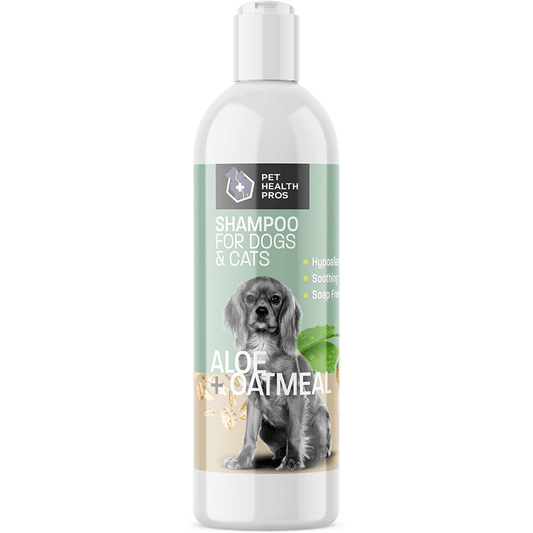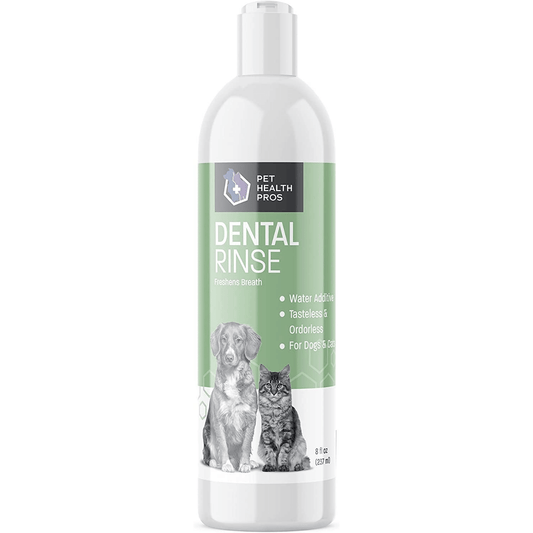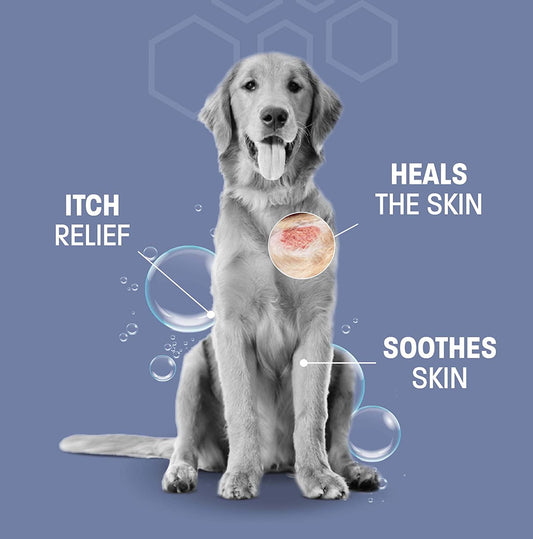
Ear mites in dogs can be a real pain! Our guide is here to help. Causes, symptoms and treatments - all the info you need to get your pup back to wagging their tail!
These mites are tiny parasites that live in the ear canal. Symptoms like itching, redness and irritation can get worse if not treated. And it's highly contagious - so if your pup has it, be sure to take extra steps to protect other pets in your home.
Did you know? Puppies and young dogs are especially vulnerable due to their developing immune systems. Regular check-ups and treatment can help keep them safe.
Spotting and treating ear mites is essential for your pup's health. Our guide provides all the knowledge you need. Let's get your dog back to their playful self!
Understanding Ear Mite Infestations
Ear mite infestations are a frequent occurrence among dogs, causing much concern for pet owners. To help our furry friends get back to their playful selves, it is essential to be aware of the causes, symptoms, and treatment solutions.
Let's take a look at the details in this table:
| Aspect | Description |
|---|---|
| Causes | Ear mites are tiny parasites which love warm, humid ears. |
| Symptoms | Common signs are scratching, head shaking, and odor. |
| Transmission | Ear mites can spread through contact with an infected dog. |
| Diagnosis | A vet can confirm ear mites with a test. |
| Treatment | Ear drops or oral medications are the usual treatments. |
The table gives us useful information, but there are some unique facts about ear mite infestations:
- They affect not only dogs, but cats and ferrets too.
- Humans can't get them from pets; these parasites target a single species.
- Cleaning our dog's ears regularly may stop ear mite infestations.
The importance of timely treatment is illustrated by the story of an old woman who thought her dog's scratching was due to allergies. Sadly, her delay in getting help led to her companion's discomfort.
By understanding ear mite infestations and treating them swiftly, we can make sure our furry friends have a happy, healthy life free from pesky parasites.
Causes of Ear Mite Infestations
Ear Mite Infestations - What Causes These Annoying Ear Mites in Dogs?
Ear mite infestations in dogs can be triggered by various factors. These tiny parasites, scientifically known as Otodectes cynotis, are highly contagious and can be contracted from infected animals or objects. They thrive in warm and humid environments, making dogs with poorly ventilated living spaces more susceptible. Regular contact with other animals, such as during boarding or breeding, also increases the risk of ear mite infestation. Additionally, dogs with weakened immune systems may experience a higher incidence of ear mite infestations.
To elaborate, the causes of ear mite infestations primarily revolve around transmission and environmental conditions. Direct contact with an infected animal, such as through close proximity or shared grooming tools, is a common mode of transmission. Moreover, fomites, which are inanimate objects carrying the parasites, can also contribute to the spread of ear mites. These may include bedding, toys, or even the owner's clothing.
Furthermore, certain environmental factors greatly facilitate the growth and survival of ear mites. High humidity levels, especially in areas where dogs spend extended periods of time, provide an ideal breeding ground for these pests. Crowded and unclean living spaces also contribute to the proliferation of ear mite infestations.
To prevent and address ear mite infestations, regular hygiene practices are crucial. Cleaning and disinfecting the dog's living area, as well as properly laundering their bedding and toys, can help eliminate any potential sources of infection. Additionally, routine ear checks and cleaning can detect early signs of infestation, allowing for prompt treatment. Seeking professional veterinary advice is recommended for effective and safe treatment options.
Pro Tip: Maintaining good overall hygiene and providing a clean and well-ventilated environment for your dog can significantly reduce the risk of ear mite infestations. Regular veterinary check-ups and early detection are key to effectively managing and treating these pesky parasites.
Get ready for some close encounters of the itchy kind as we dive into the dangers of direct contact with infected animals.
Direct Contact with Infected Animals
Direct contact with a contaminated animal is a major trigger of ear mite infestations. To understand how these minuscule critters gain entry to our furry pals' ears, here are some crucial facts.
- Ear mites are highly contagious and can be quickly passed along from one animal to another through direct contact.
- This type of transmission happens frequently during social activities between animals, like playing or grooming.
- The close proximity allows the mites to crawl from one host to another, making it easy for them to find a new home in the ears of an uninfected animal.
- Even short meetings with infected animals can cause the transfer of ear mites, emphasizing the need for caution when introducing pets to strange companions.
Though direct contact with contaminated animals is a key cause of ear mite infestations, other significant points are worth mentioning. These annoying parasites thrive in warm and moist atmospheres, explaining why they so often target the ears. Moreover, their miniature size causes them to be hard to spot without proper examination, adding to their capability to spread unobserved.
A definite fact: According to The American Animal Hospital Association (AAHA), ear mites are most often discovered in cats and dogs, but can also affect other domesticated animals such as ferrets and rabbits.
By recognizing how ear mites spread through direct contact with infected animals, we can take the necessary measures to prevent the infestation from happening or spreading further.
Environmental Contamination
Ear mite infestations in pets can be caused by environmental contamination. Let's look at the factors that contribute to this.
Animals that are close together can spread the mites to each other. Shared bedding or toys are also a risk.
Poor hygiene can create a breeding ground for ear mites - warm and damp areas like pet living spaces need to be cleaned often.
Animals that spend time outdoors are more vulnerable to external sources of infection, like contaminated soil or plant matter.
Pet owners must take action to prevent environmental contamination from ear mites. Cleaning and disinfecting pet items and keeping pets indoors can help.
Don't let your pet suffer! Take steps now to protect them from discomfort due to ear mites.
Symptoms of Ear Mite Infestations
Ear Mite Infestations: Recognizing the Signs
Ear mite infestations in dogs can cause a range of symptoms that are indicative of the presence of these tiny parasites. By understanding and recognizing these signs, you can take prompt action to alleviate your dog's discomfort. Here are the key symptoms to watch out for:
- Ear scratching: Dogs with ear mite infestations often scratch their ears excessively. Keep an eye out for frequent scratching or rubbing of the ears.
- Head shaking: If your dog shakes their head frequently, it could indicate the presence of ear mites. This behavior is their way of trying to alleviate the discomfort caused by these pesky parasites.
- Ear discharge: One of the most common symptoms of ear mite infestations is the presence of a dark, waxy discharge in the ears. This discharge may have a foul odor.
- Redness and inflammation: Ear mites can cause irritation and inflammation of the ear canal, leading to redness and swelling. Check for any signs of redness or inflammation when examining your dog's ears.
- Crusty skin around the ears: Ear mites can cause the skin around the ears to become dry, crusty, and flaky. Look for any abnormalities in the skin texture or appearance.
- Hair loss: In severe cases of ear mite infestations, your dog may experience hair loss around the ears. This is a result of excessive scratching and irritation.
While these symptoms are common indicators of ear mite infestations, it's important to note that each dog may exhibit slightly different signs. If you notice any of these symptoms or suspect an ear mite infestation, it is crucial to consult with your veterinarian for a proper diagnosis and treatment plan.
To help alleviate your dog's discomfort and treat ear mite infestations effectively, consider the following suggestions:
- Cleaning: Regularly clean your dog's ears using a gentle, veterinarian-recommended ear cleaner to remove excess wax and debris. Cleaning can help eliminate some ear mites and reduce irritation.
- Medication: Your veterinarian may prescribe ear drops or medications to specifically target and eliminate ear mites. Follow their instructions carefully and administer the medication as directed for optimal results.
- Environmental management: Ear mites can survive in the environment and reinfest your dog. Thoroughly clean and disinfect your dog's bedding, toys, and living areas to minimize the risk of reinfestation.
By recognizing the symptoms of ear mite infestations early on and taking appropriate measures, you can help ensure that your dog stays healthy, comfortable, and free from these bothersome parasites. Always consult with your veterinarian for personalized advice and guidance tailored to your dog's specific needs.
Ear mites got your dog scratching like a DJ with an itch for some sick beats.
Itching and Scratching of the Ears
Excessive itching and scratching of the ears can be a sign of ear mite infestations. These parasites, known as Otodectes cynotis, can cause discomfort for our pets. To recognize this, we should look out for several points:
- The animal will paw at their ears or shake their head.
- They may rub their ears against objects to stop the itching.
- Scratching may create sores or scabs on the ear flaps.
- There may also be hair loss due to constant scratching.
Itchy ears can't always confirm the presence of ear mites. But, if accompanied by dark discharge and a bad smell, it's likely an infestation is there.
It can be distressing for pets and pet owners. Ear mites can invade without warning, leading to complications if left untreated.
It is important to recognize the symptom and take action early. This will help manage the situation and give our furry friends comfort. Be attentive and get professional help when needed.
Redness and Irritation of the Ear Canal
Redness and irritation can be an indicator of ear mite infestations. It's often accompanied by intense itching, discomfort, and pain. This is caused by the mites burrowing into the skin and triggering an inflammatory response. Scratching and rubbing of the affected area further exacerbates the irritation.
Discharge or Bad Odor from the Ears
Ears naturally produce earwax, but when there's too much or it smells bad, it can mean a critter called Otodectes cynotis has moved in. These are parasites known as ear mites, common in cats and dogs. They eat the host's skin cells and fluids, causing inflammation and a smelly, dark discharge.
Telltale signs of infestation? Pets shake their heads and scratch their ears fiercely. They may also rub their heads on furniture. That's what happened to my friend's cat. Worried, she took the cat to the vet. The vet confirmed the infestation after a physical exam and microscopic analysis.
Diagnosing Ear Mite Infestations
Diagnosing Ear Mite Infestations can be done through various methods.
- Physical examination: A veterinarian can examine the dog's ears for common signs of ear mite infestations such as redness, swelling, and debris.
- Microscopic examination: The vet may take swabs of the ear discharge and examine them under a microscope to identify the presence of ear mites.
- Ear mite test kits: These kits can be used at home to collect ear discharge samples, which are then sent to a laboratory for analysis.
- Allergen testing: Sometimes, dogs may have allergic reactions to ear mites, and allergy testing can help identify the specific allergens.
- Trial treatment: If other methods are inconclusive, the vet may prescribe a medication that is effective against ear mites. If the dog's symptoms improve with the treatment, it confirms the diagnosis.
It's important to note that the symptoms of ear mite infestations, such as itching and head shaking, can overlap with other ear conditions. Therefore, a proper diagnosis by a veterinarian is crucial to ensure proper treatment.
In addition to the diagnostic methods mentioned above, a thorough examination of the dog's medical history and a discussion with the owner about the dog's symptoms can also contribute to the diagnosis.
Remember, if you suspect your dog has ear mites, it's important to consult with a veterinarian for an accurate diagnosis and appropriate treatment. Prepare your dog to be judged (by a professional) at the vet's office as you tackle those pesky ear mites.
Visiting a Veterinarian
Seeing a vet is essential for diagnosing ear mite infestations. Here's what to consider:
- Book an appointment with a qualified vet who specializes in small animals.
- The vet will examine your pet's ears using special tools and methods.
- Look for signs of ear mites like itching, inflammation, discharge, and dark wax.
- The vet could take a sample of the discharge to check for mites.
- Based on the severity, the vet will prescribe treatments and preventive measures.
- It's possible you'll need follow-up visits to make sure the mites are gone.
To make the most of the vet visit, keep this in mind:
- Choose a vet who is familiar with ear mite infestations.
- Bring relevant medical history or documents.
- Notice any specific symptoms or behavior changes before the appointment.
Pro Tip: Don't delay seeing a professional if you think your pet has ear mites. Early detection and treatment prevents more discomfort and issues.
Ear Swabbing and Microscopic Examination
Ear swabbing and microscopic examination is a key way to diagnose ear mite infestations. This process involves taking a sample from the infected ear and viewing it under a microscope to detect the presence of mites.
To do this test, a veterinarian or trained expert carefully inserts a sterile swab into the ear canal to get cerumen (ear wax) and any debris. The material is then moved to a glass slide and treated with a special dye to show the presence of mites.
The table below outlines the major steps in the process:
| Step | Description |
|---|---|
| 1 | Anesthesia is given to make the animal comfortable. |
| 2 | The external ear canal is checked for inflammation or discharge. |
| 3 | A sterile swab is put in the ear canal to get samples. |
| 4 | The material is moved to a glass slide. |
| 5 | A special stain is used to make the mites visible under the microscope. |
| 6 | The slide is examined under high magnification for mites or their eggs. |
| 7 | If positive, the owner is informed of the treatment options. |
It's important to note that in some cases, multiple swabs may be needed for more accuracy. Also, skin scrapings and other tests may be done. This detailed examination helps make sure the diagnosis is correct and lets veterinarians give the right treatment to affected animals.
If you think your pet might have ear mite infestation, don't hesitate to get help. Quick detection and intervention can stop issues and make your pet feel better. Always remember, caring for your pet should be your top priority!
Treating Ear Mite Infestations
Treating Ear Mite Infestations:
Ear mite infestations can be effectively treated to alleviate discomfort and restore your dog's well-being. Follow this simple 3-step guide to address the issue promptly and efficiently.
- Identification and Diagnosis: Begin by examining your dog's ears for signs of ear mite infestation, such as excessive scratching, head shaking, and dark, crumbly discharge. If you suspect ear mites, consult a veterinarian for a thorough examination and an accurate diagnosis.
- Medication and Cleanliness: Once diagnosed, your veterinarian may prescribe ear drops or other topical treatments to eliminate the ear mites. Follow their instructions carefully and administer the medication as directed. Additionally, clean your dog's ears regularly using a veterinarian-recommended ear cleanser to remove debris and prevent further infestation.
- Prevention and Follow-up: To prevent future ear mite infestations, maintain a clean and hygienic environment for your dog. Regularly clean their bedding, toys, and grooming tools. Additionally, schedule routine check-ups with your veterinarian to ensure your dog's ears remain healthy and mite-free.
By implementing these measures, you can effectively treat ear mite infestations in your dog, promoting their well-being and preventing recurring issues.
In addition to the steps outlined above, it's essential to understand that each dog's situation may vary. Consulting a veterinarian is crucial to ensure a tailored treatment plan tailored to your dog's specific needs.
Once, a worried dog owner noticed her pet constantly scratching its ears and exhibiting discomfort. Upon seeking veterinary assistance, it was determined that the dog had a severe ear mite infestation. The diligent application of prescribed ear drops and regular cleaning resolved the issue, and the dog made a full recovery. This real-life example highlights the importance of promptly addressing ear mite infestations to alleviate your dog's suffering and restore their playful nature..
Prescription Medications
Consulting a vet is essential before giving your pet any prescription medication. The most common forms are topical treatments such as ear drops, ointments, or oral medications like tablets and liquids. These meds are more powerful and faster compared to the over-the-counter options. Adhere closely to dosage instructions for successful treatment!
Plus, prescription meds are effective for both adult mites and their eggs, guaranteeing full elimination. Consistency is key in using them, so stick to your pet's treatment schedule!
Home Remedies
Mineral oil, a few drops, can smother mites and ease the itchiness and discomfort.
Vinegar, watered down, and a cotton ball to clean pet ears will make the environment unfriendly to mites.
Tea tree oil blended with coconut oil, and dabbed on with a cotton ball, offers antiseptic properties to soothe skin and eradicate mites.
Aloe vera gel, a smidge, can reduce ear mite infestations' inflammation.
Neem oil, mixed with equal parts olive or almond oil, is a great ear drop solution. It has insecticidal properties to help get rid of the mites.
Regular vacuuming, washing bedding, and keeping the environment clean prevents reinfestation.
If your pet has open wounds or severe symptoms, don't use home remedies. Seek professional veterinary care!
Do all of this for your pet's well-being. They will thank you!
Cleaning the Ears
Cleaning your pet's ears is important to treat ear mite infestations. Follow these 3 steps for relief:
- Inspect your pet's ears for redness, inflammation, wax or dark discharge. These are signs of ear mites.
- Make a cleaning solution with equal parts warm water and vinegar or special ear cleaning solution from the vet.
- Use a clean cotton ball or pad with the solution. Gently wipe the inside of the ears in a circular motion to remove any debris. Do this to both ears.
Regular ear cleaning helps prevent future infestations and keeps your pet's ear health.
Remember, regular cleaning is key to treating ear mites and providing comfort for your pet. Follow these steps and seek professional help if needed to help your furry friend overcome this common issue.
Preventing Ear Mite Infestations
Preventing Ear Mite Infestations:
To ensure your dog remains free from ear mite infestations, implement the following preventive measures:
- Regular cleaning: Clean your dog's ears at least once a week with a gentle, veterinary-approved ear cleanser.
- Inspect regularly: Routinely examine your dog's ears for any signs of ear mites, such as itching, redness, or discharge.
- Maintain hygiene: Keep your dog's living area clean, including their bedding and toys, to minimize the risk of ear mite transmission.
- Avoid contact: Limit your dog's exposure to stray animals or those with suspected ear mite infestations to reduce the chances of infection.
- Regular veterinary check-ups: Take your dog for routine check-ups to detect any early signs of ear mite infestation and seek prompt treatment.
- Treat all pets: If you have multiple pets at home, ensure that all of them are treated simultaneously to prevent mite transfer between them.
In addition to these preventive measures, it is crucial to be aware that ear mites can survive in the environment for up to three weeks. Therefore, thorough cleansing of your dog's surroundings is essential to minimize the risk of reinfestation.
To further safeguard your dog's ears from mite infestations, it is advisable to consult your veterinarian for personalized advice and recommendations. By taking proactive measures, you can help ensure your dog's ear health and overall well-being.
Clean ears, happy pup - because no one wants a dog with enough earwax to seal an envelope.
Regular Ear Checks and Cleaning
Checking and cleaning your ears is essential for preventing mite infestations. To keep them healthy:
- Look for signs of mites, such as redness, swelling, or a dark discharge.
- Use a vet-recommended ear cleaner on a cotton ball to wipe the inside.
- Be careful not to put anything too deep into the canal.
- Clean the outer part of the ears to remove dirt.
These steps also help detect infections or foreign objects. With good hygiene and vet advice, you can keep ears free from mites and in great condition. Pet owners must be aware of mites and their effects. Regular ear checks and cleaning can stop them from taking over. Your care will make a difference!
Isolating Infected Animals
To stop ear mite from spreading, it's necessary to seclude sick animals. This helps to contain the infestation and reduce danger of transmission to other pets. Follow these steps to effectively isolate affected animals:
- Find the infected animal by looking for signs such as intense head shaking, scratching, and dark debris in the ears.
- Create a separate living area for the sick animal away from healthy ones.
- Provide essentials like food, water, bedding, toys, and litter box in the isolated area.
- Avoid direct contact with the unwell pet by using gloves and staying clean.
- Regularly clean and disinfect the isolated area to decrease mite survival.
- Consult a vet for accurate diagnosis, treatment, and advice on how long to keep the animal separate.
Also, make sure to sanitize any shared spaces or objects thoroughly to stop cross-contamination.
It's essential to isolate infected animals to prevent ear mites from spreading. By taking rapid action and following these steps carefully, you can secure all your pets from this annoying condition. Give your pets the care they deserve! Take control of their health today by isolating affected animals quickly, saving them from discomfort and expensive treatments. Act now!
Environmental Cleaning
Preventing ear mite infestations is always better than trying to cure them. People, pets, and even humans can get infected in close contact with animals that have mites. To safeguard well-being and protect from potential health risks, environmental cleaning is important.
Vacuuming and dusting your home regularly helps remove any potential breeding grounds for mites. Pay attention to pet areas, like furniture, bedding, and carpets.
Wash pet bedding and toys in hot water to eliminate mites or eggs.
Use a pet-safe disinfectant on hard surfaces to kill mites and prevent reinfestation.
Keep outdoor areas clean and clear of debris. This discourages wildlife from introducing ear mites.
Regularly grooming pets helps detect signs of infestation early. Prompt treatment can be sought before it becomes a bigger problem.
In ancient Egypt, people recognized the importance of cleanliness. They used natural remedies, e.g. olive oil and vinegar, to clean their ears. This helped prevent ear mite infestations.
Conclusion
My friend had a furry friend who was itchy and uncomfortable. She realized he had an ear mite infestation. She learnt about the causes, signs, and solutions by reading about it.
We discussed the issues around ear mites in dogs. We looked at treatments from pharmacy medicines to home remedies. To make sure our dogs are happy and healthy, we must take action.
It's important to stop ear mite infestations before they happen. Cleaning our pooches' ears and staying hygienic helps lower the chance of mites taking hold. Regular check-ups with a vet are essential too.
My friend treated her pup. With the right care, her pup was back to being playful and happy.
Frequently Asked Questions
1. What are the causes of ear mite infestations in dogs?
Ear mite infestations in dogs are commonly caused by a species of mites called Otodectes cynotis. These tiny parasites are easily transmitted from one pet to another through direct contact. Stray dogs, cats, or even wildlife can also carry these mites, leading to infestations in dogs.
2. What are the symptoms of ear mite infestations in dogs?
Signs of ear mite infestations in dogs include frequent scratching or rubbing of the ears, head shaking, dark discharge resembling coffee grounds in the ear canals, redness or inflammation, and foul odor coming from the ears. Excessive ear scratching can lead to sores or wounds on the ear flap or around the ear.
3. How can I identify if my dog has ear mites?
The best way to identify ear mites in dogs is through a microscopic examination of ear discharge. If you notice any symptoms mentioned earlier, you should consult your veterinarian. They can take a sample from your dog's ear, examine it under a microscope, and confirm the presence of ear mites.
4. What are the treatment options for ear mite infestations in dogs?
Treatment for ear mite infestations in dogs usually involves thorough cleaning of the ears and the use of specific medications. Your veterinarian may prescribe eardrops or topical ointments to kill the mites, as well as additional treatments to alleviate any resulting infections or inflammations.
5. Can I prevent my dog from getting ear mites?
While it may not be possible to completely prevent ear mites in dogs, there are a few measures you can take to reduce the risk. Regularly cleaning your dog's ears, especially if they have been in contact with other pets, can help remove potential mites. Additionally, keeping your dog's living environment clean and ensuring their overall health and hygiene can also help prevent ear mite infestations.
6. Are ear mites contagious to humans?
No, ear mites infesting dogs are not contagious to humans. Although they can cause temporary itching or irritation if they come into contact with human skin, they cannot establish an infestation in humans. However, if your dog has ear mites, it is still important to seek timely treatment to prevent discomfort and further complications for your pet.









